 Back in 2019 Benoit Pioulard (Thomas Meluch) issued Sylva—an album full of abstract hyper-saturated lo-fi drone-pop sonic textures, which came with an 84 page collection of nature photographs in a linen book. Two pieces with vocals stood out: the brilliantly Bibioesque "Keep" and the less jangly but equally catchy "Meristem." These songs could not have been more appealing to me if Meluch had somehow used a machine to extract my personal dream essence as I slept. Naturally, I promptly forgot to write anything about Sylva, but Eidetic is a leap forward, with more vocals, so I'm glad I kept my powder dry.
Back in 2019 Benoit Pioulard (Thomas Meluch) issued Sylva—an album full of abstract hyper-saturated lo-fi drone-pop sonic textures, which came with an 84 page collection of nature photographs in a linen book. Two pieces with vocals stood out: the brilliantly Bibioesque "Keep" and the less jangly but equally catchy "Meristem." These songs could not have been more appealing to me if Meluch had somehow used a machine to extract my personal dream essence as I slept. Naturally, I promptly forgot to write anything about Sylva, but Eidetic is a leap forward, with more vocals, so I'm glad I kept my powder dry.
Distraction is embedded into modern life and that is why I did not write about Sylva, rather than a consequence of memory. I know this because the record left an impression and I've listened to it several times since 2019. It was stored in at least my short term, if not long term, memory. Eidetic memory, controlled primarily by the posterior parietal cortex of the parietal lobe of the brain, is a temporary form of short-term memory. Everyone has eidetic memory to a degree; it is the ability to see something soon after you look away. For most people, the image lasts from a fraction of a second to maybe a couple of seconds. Visual images in eidetic memory are either discarded or passed to short-term memory where they may be recalled for days, weeks, or months, then discarded or relayed to long-term memory. Of course since both Sylva and Eidetic are audio information this may not be literally pertinent but it is a way to begin to approach Eidetic and to paraphrase Basil Fawlty with his German guests "you (Thomas Meluch) started it."


 Every so often a beautifully flawed pseudo-concept album gets released which it is almost a sin to try to describe. So it is with this absolutely mesmerizing record, a taste-smashing, fabulously old-fashioned, wobbly blitzkrieg of slippery, retro-futuristic, prog rock precision. As a rule I try to avoid describing music by talking about other music the reader may or may not have heard, but the gloves are coming off for this one. Imagine if modern psych groups weren't so one-paced, if Barclay James Harvest had a wah wah pedal and enjoyed fiddling with tape speeds, if Yes were fronted by Serge Gainsbourg or had a sense of humor, if The Opium Warlords and Bo Hansen joined The Mike Sammes Singers; and it all sounded perfectly natural. Juxtaposition and incongruity are at the heart of The Valley of The Dandies: a wonderfully unpredictable recording which manages to sound deliberately dated, and also touches on mythical themes ("explored" would be an exaggeration) but not in a po-faced or over-referential manner. The music is sometimes grandiose but CV Vision does not portray by resorting to a dull slow burn plodding pace. These tunes are amusing, bright, clever, and dynamic, the lyrics intriguingly clumsy but yet light and unobtrusive. There is an unknowable quality to this album, though; and a certain confidence in its completeness. It can not be reduced to a few neat genres, has a rich complexity but never sounds cluttered or gets bogged down. This is a real gem: clean, clear and valuable. It may become a cult classic or merely prove to be a refreshing oddity. Either way I played this thing through five times without a break!
Every so often a beautifully flawed pseudo-concept album gets released which it is almost a sin to try to describe. So it is with this absolutely mesmerizing record, a taste-smashing, fabulously old-fashioned, wobbly blitzkrieg of slippery, retro-futuristic, prog rock precision. As a rule I try to avoid describing music by talking about other music the reader may or may not have heard, but the gloves are coming off for this one. Imagine if modern psych groups weren't so one-paced, if Barclay James Harvest had a wah wah pedal and enjoyed fiddling with tape speeds, if Yes were fronted by Serge Gainsbourg or had a sense of humor, if The Opium Warlords and Bo Hansen joined The Mike Sammes Singers; and it all sounded perfectly natural. Juxtaposition and incongruity are at the heart of The Valley of The Dandies: a wonderfully unpredictable recording which manages to sound deliberately dated, and also touches on mythical themes ("explored" would be an exaggeration) but not in a po-faced or over-referential manner. The music is sometimes grandiose but CV Vision does not portray by resorting to a dull slow burn plodding pace. These tunes are amusing, bright, clever, and dynamic, the lyrics intriguingly clumsy but yet light and unobtrusive. There is an unknowable quality to this album, though; and a certain confidence in its completeness. It can not be reduced to a few neat genres, has a rich complexity but never sounds cluttered or gets bogged down. This is a real gem: clean, clear and valuable. It may become a cult classic or merely prove to be a refreshing oddity. Either way I played this thing through five times without a break! The latest ambitious durational epic from the Opalio brothers is thankfully not nearly as daunting as its 15-disc physical form suggests, as RINASCIMENTO ("Renaissance") is composed of 15 movements of varying lengths ranging from 5 to 40 minutes. The reasoning behind the unusual format is arguably twofold, as the Opalios' belief that "each sound claims its own space" is extended to dedicate a full disc to each movement and listeners are invited to "subvert the order" to make use of "random/chance operation à la Cage." There is an additional piece to the puzzle as well, however, as the handcrafted box and CD-R format were deliberately chosen as a return to MCIAA's "radical DIY" origins and as a pointed commentary on underground music's current maddening dependence on vinyl pressing plants and predatory corporations. Unsurprisingly, the primary appeal of RINASCIMENTO is the same as that of every other multi-hour MCIAA tour de force: it is a sustained and mind-altering plunge into otherworldly psychedelia that abandons nearly all earthbound notions of harmony, melody, structure, and instrumentation (and that is not an exaggeration). While the brothers' sonic palette will be a familiar one for longtime MCIAA fans (being a two-person real-time "spontaneous composition" project has some limitations), RINASCIMENTO is nevertheless one hell of a statement, as it collects the duo's most revelatory flashes of inspiration from an entire year of recordings (several of which capture the duo in peak longform form).
The latest ambitious durational epic from the Opalio brothers is thankfully not nearly as daunting as its 15-disc physical form suggests, as RINASCIMENTO ("Renaissance") is composed of 15 movements of varying lengths ranging from 5 to 40 minutes. The reasoning behind the unusual format is arguably twofold, as the Opalios' belief that "each sound claims its own space" is extended to dedicate a full disc to each movement and listeners are invited to "subvert the order" to make use of "random/chance operation à la Cage." There is an additional piece to the puzzle as well, however, as the handcrafted box and CD-R format were deliberately chosen as a return to MCIAA's "radical DIY" origins and as a pointed commentary on underground music's current maddening dependence on vinyl pressing plants and predatory corporations. Unsurprisingly, the primary appeal of RINASCIMENTO is the same as that of every other multi-hour MCIAA tour de force: it is a sustained and mind-altering plunge into otherworldly psychedelia that abandons nearly all earthbound notions of harmony, melody, structure, and instrumentation (and that is not an exaggeration). While the brothers' sonic palette will be a familiar one for longtime MCIAA fans (being a two-person real-time "spontaneous composition" project has some limitations), RINASCIMENTO is nevertheless one hell of a statement, as it collects the duo's most revelatory flashes of inspiration from an entire year of recordings (several of which capture the duo in peak longform form). This is the second solo album from NYC-based violist/composer/musicologist Annie Garlid and it borrows its name from the Greek word for "place." Notably, Garlid moved back to the US in 2018 after spending a decade in Europe (playing viola in a German opera orchestra, among other things) and that return to her home country unsurprisingly stirred up some deep and unfamiliar thoughts and feelings. Those ruminations directly inspired Topos conceptually, as the album is a meditation on the "simultaneous familiarity and foreignness" of Garlid's surroundings and her entanglement "with a place that was both in her memory and in front of her eyes." Regardless of its inspirations, Topos is a very different (and stronger) album than its predecessor United, as Garlid's medieval and baroque influences are newly downplayed in favor of a more sensuous, hallucinatory, and vocal-centric vision. While that transformation makes a lot of sense given Garlid's work with artists like Caterina Barbieri, Holly Herndon, Emptyset, and ASMR artist Claire Tolan, her assimilation of those disparate influences is impressively seamless and inventive, as Topos feels like the blossoming of a compelling and distinctive new vision.
This is the second solo album from NYC-based violist/composer/musicologist Annie Garlid and it borrows its name from the Greek word for "place." Notably, Garlid moved back to the US in 2018 after spending a decade in Europe (playing viola in a German opera orchestra, among other things) and that return to her home country unsurprisingly stirred up some deep and unfamiliar thoughts and feelings. Those ruminations directly inspired Topos conceptually, as the album is a meditation on the "simultaneous familiarity and foreignness" of Garlid's surroundings and her entanglement "with a place that was both in her memory and in front of her eyes." Regardless of its inspirations, Topos is a very different (and stronger) album than its predecessor United, as Garlid's medieval and baroque influences are newly downplayed in favor of a more sensuous, hallucinatory, and vocal-centric vision. While that transformation makes a lot of sense given Garlid's work with artists like Caterina Barbieri, Holly Herndon, Emptyset, and ASMR artist Claire Tolan, her assimilation of those disparate influences is impressively seamless and inventive, as Topos feels like the blossoming of a compelling and distinctive new vision. Just about anything which bucks stereotypes, and the more effortlessly the better, is usually fine and dandy with me. The notion of a sustained outbreak of surrealism down in Alabama is therefore beyond delicious. I say this because there's a definite sense in which Turner Williams Jr. is following in the rambling loose limbed footsteps of such musicians as Ron Pate, Fred Lane, LaDonna Smith, and particularly Davey Williams, who studied with Johnny Shines and was part of the whole Raudelunas Pataphysical Revue scene - playing alto and guitar on such pieces as "The Lonely Astronaut" and "Concerto For Active Frogs''. Let me say here that the origin of pataphysics is perhaps best left to another time, since Alfred Jarry's absurdity and all that merde (absinthe-fueled and otherwise) simply cannot be skimmed over.
Just about anything which bucks stereotypes, and the more effortlessly the better, is usually fine and dandy with me. The notion of a sustained outbreak of surrealism down in Alabama is therefore beyond delicious. I say this because there's a definite sense in which Turner Williams Jr. is following in the rambling loose limbed footsteps of such musicians as Ron Pate, Fred Lane, LaDonna Smith, and particularly Davey Williams, who studied with Johnny Shines and was part of the whole Raudelunas Pataphysical Revue scene - playing alto and guitar on such pieces as "The Lonely Astronaut" and "Concerto For Active Frogs''. Let me say here that the origin of pataphysics is perhaps best left to another time, since Alfred Jarry's absurdity and all that merde (absinthe-fueled and otherwise) simply cannot be skimmed over. This is the fifth album of traditional folk tunes which Alasdair Roberts has issued. He has also released several albums of his own compositions and it is a mark of his skill that it is pretty much impossible to tell the difference, and to know whether songs are his own imaginings or not. All share an erudite sensibility, often mixing his plaintive ghostly wailing voice (sometimes mournful, often joyous) with fine, spidery, guitar accompaniment. This new record is a deep collection, full of sweet spots, rich in detail, crystal clear in execution, and teeming with life. As usual, he reveals the multilayered meanings and nuances in even the most apparently straightforward songs, as with "The Bonny Moorhen" of Celtic folklore, and "Drimindown," a simple tale of a lost cow but also a devastating loss of a family's livelihood.
This is the fifth album of traditional folk tunes which Alasdair Roberts has issued. He has also released several albums of his own compositions and it is a mark of his skill that it is pretty much impossible to tell the difference, and to know whether songs are his own imaginings or not. All share an erudite sensibility, often mixing his plaintive ghostly wailing voice (sometimes mournful, often joyous) with fine, spidery, guitar accompaniment. This new record is a deep collection, full of sweet spots, rich in detail, crystal clear in execution, and teeming with life. As usual, he reveals the multilayered meanings and nuances in even the most apparently straightforward songs, as with "The Bonny Moorhen" of Celtic folklore, and "Drimindown," a simple tale of a lost cow but also a devastating loss of a family's livelihood. This latest album from Markus Popp marks yet another intriguing stylistic detour for his endlessly shapeshifting Oval project, as he delves into "an omnipresent and yet oft ill-defined, even maligned area of music and art–the romantic." The idea for this album first began as a multimedia collaboration with digital artist Robert Seidel intended for the grand opening of Frankfurt's German Romantic Museum, but the endeavor soon evolved and expanded beyond the original purpose, as the two artists "sought a more expansive definition of 'romantic,' extending outward from the museum's comprehensive survey of the 19th-century epoch in art." That said, I suspect only Popp knows how influences from literature, architecture, and visual art helped shape the album, as my ears can only process the final destination and not the journey. In the case of Romantiq, that destination feels like a series of brief vignettes/miniatures assembled from period instrumentation and filtered through Popp's fragmented and idiosyncratic vision. Given that this is an Oval album, of course, very few of the 19th-century sounds are instantly recognizable as such (aside from some occasional piano), but Popp's kaleidoscopic and deconstructed homage to the past is a characteristically compelling and intriguingly unique outlier in the Oval canon (and it is often a textural marvel as well).
This latest album from Markus Popp marks yet another intriguing stylistic detour for his endlessly shapeshifting Oval project, as he delves into "an omnipresent and yet oft ill-defined, even maligned area of music and art–the romantic." The idea for this album first began as a multimedia collaboration with digital artist Robert Seidel intended for the grand opening of Frankfurt's German Romantic Museum, but the endeavor soon evolved and expanded beyond the original purpose, as the two artists "sought a more expansive definition of 'romantic,' extending outward from the museum's comprehensive survey of the 19th-century epoch in art." That said, I suspect only Popp knows how influences from literature, architecture, and visual art helped shape the album, as my ears can only process the final destination and not the journey. In the case of Romantiq, that destination feels like a series of brief vignettes/miniatures assembled from period instrumentation and filtered through Popp's fragmented and idiosyncratic vision. Given that this is an Oval album, of course, very few of the 19th-century sounds are instantly recognizable as such (aside from some occasional piano), but Popp's kaleidoscopic and deconstructed homage to the past is a characteristically compelling and intriguingly unique outlier in the Oval canon (and it is often a textural marvel as well). I am obsessed with circles, but you don't need to share that obsession to notice and appreciate the gesture of respect here from Tujiko Noriko to Peter Rehberg with the insistence that Crepuscule I & II be issued in various formats, including cassette. Many years ago she dropped a cassette tape into the hands of the MEGO and Editions MEGO label founder. The tape contained her first album and, despite it being a big departure from the typically more brash and raw fare he was normally releasing, Rehberg liked what he heard and gave it a proper push. Universal acclaim did not follow.
I am obsessed with circles, but you don't need to share that obsession to notice and appreciate the gesture of respect here from Tujiko Noriko to Peter Rehberg with the insistence that Crepuscule I & II be issued in various formats, including cassette. Many years ago she dropped a cassette tape into the hands of the MEGO and Editions MEGO label founder. The tape contained her first album and, despite it being a big departure from the typically more brash and raw fare he was normally releasing, Rehberg liked what he heard and gave it a proper push. Universal acclaim did not follow. 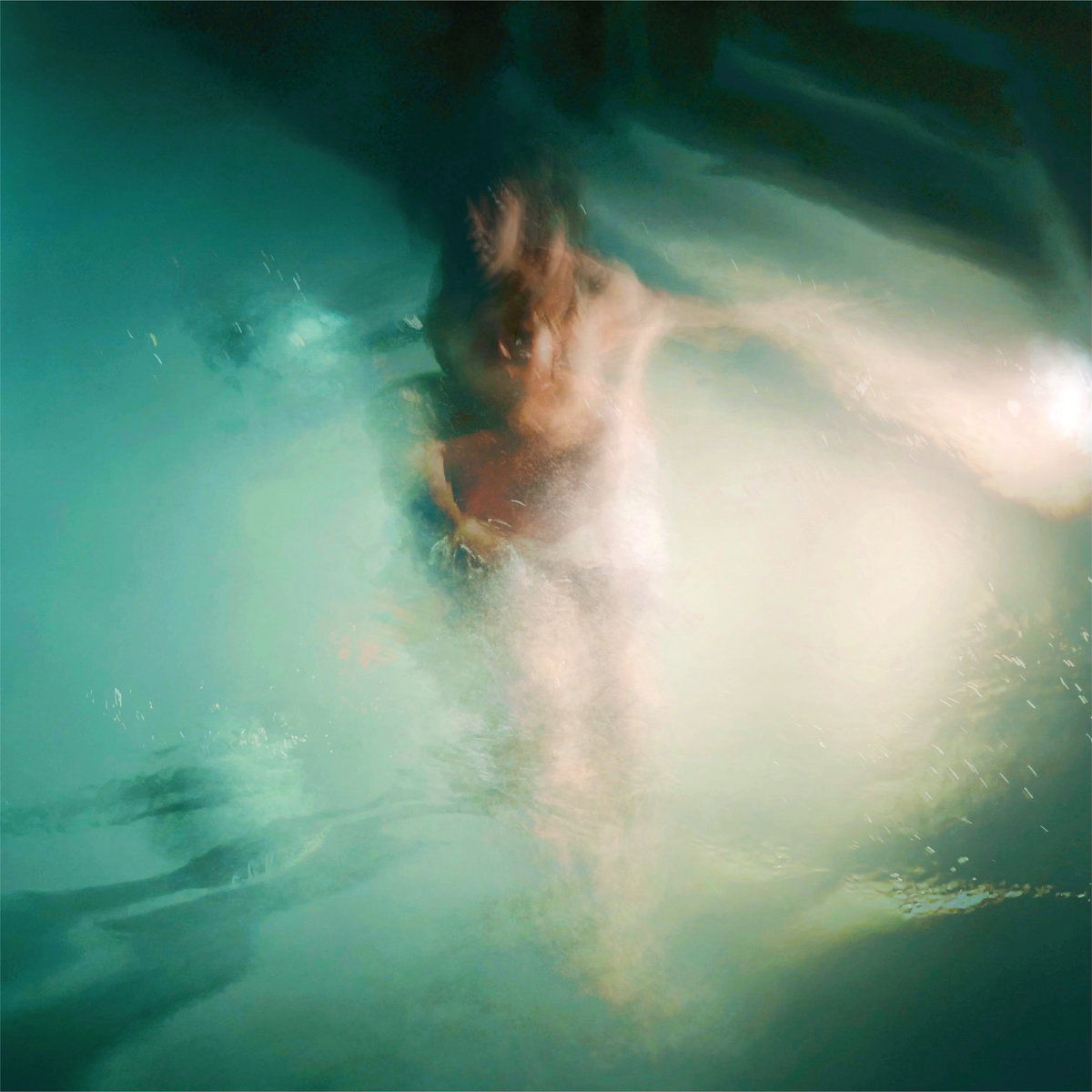 This latest full-length from Lucy Liyou is described as a "rumination on the double-sidedness of trauma and love." The title is a Korean idiom with multiple meanings ("could mean anything from fanciful daydreams to nightmarish terrors") and was chosen very deliberately, as Liyou is fascinated by what our dream lives say about us and our subconscious desires. Interestingly, Dog Dreams is billed as only Liyou's second album (she is quite a prolific artist), but apparently everything other than 2020's Welfare is considered either an EP or a collaboration. In some ways, Dog Dreams feels like a logical evolution from that debut, but I was surprised to find that Liyou moved away from her text-to-speech narratives, as I previously thought that element was absolutely central to her aesthetic. In their place, however, are elusive Robert Ashley-esque dialogues of murmuring voices hovering at the edge of intelligibility. While I expected to miss the playfully dark humor of those robotic voices quite a lot (I found them very endearing), the newly tender and human voices fit the dreamlike beauty of Dog Dreams' three sound collages quite nicely.
This latest full-length from Lucy Liyou is described as a "rumination on the double-sidedness of trauma and love." The title is a Korean idiom with multiple meanings ("could mean anything from fanciful daydreams to nightmarish terrors") and was chosen very deliberately, as Liyou is fascinated by what our dream lives say about us and our subconscious desires. Interestingly, Dog Dreams is billed as only Liyou's second album (she is quite a prolific artist), but apparently everything other than 2020's Welfare is considered either an EP or a collaboration. In some ways, Dog Dreams feels like a logical evolution from that debut, but I was surprised to find that Liyou moved away from her text-to-speech narratives, as I previously thought that element was absolutely central to her aesthetic. In their place, however, are elusive Robert Ashley-esque dialogues of murmuring voices hovering at the edge of intelligibility. While I expected to miss the playfully dark humor of those robotic voices quite a lot (I found them very endearing), the newly tender and human voices fit the dreamlike beauty of Dog Dreams' three sound collages quite nicely. Vandever's first solo album was recorded in three days and features her improvising on (mainly) trombone, effects, and voice. The improvised approach never shoves this music even an inch away from clarity, deftness, and emotional depth. Every piece feels fresh, abstract and dreamlike—as if she's channeling spirit voices from elsewhere—but all are restrained by the beguiling warmth, subtle tension, and comforting understatement of her sonorous playing. It's marvelous to hear the trombone burst, or maybe a more accurate descriptor would be slide, free of all genre association.
Vandever's first solo album was recorded in three days and features her improvising on (mainly) trombone, effects, and voice. The improvised approach never shoves this music even an inch away from clarity, deftness, and emotional depth. Every piece feels fresh, abstract and dreamlike—as if she's channeling spirit voices from elsewhere—but all are restrained by the beguiling warmth, subtle tension, and comforting understatement of her sonorous playing. It's marvelous to hear the trombone burst, or maybe a more accurate descriptor would be slide, free of all genre association. Letters From A Forest uses snippets of conversation, sung and spoken lyrics, simple guitar and piano lines, and (as Christian puts it) fake strings, to create what we can call collage atmospherics. The sum of these parts is a tender sounding album, crammed full of romanticized lyrics with a tough, honest, edge and a wondrous stream of consciousness style. When hearing tracks like the "The Ballad of Martin and Caroline,"—a tale of fates deeply entwined in a doomed love spiral—I felt like I was half napping or jet lagged in a spare room, overhearing friends babbling to one another about deceased acquaintances,musical heroes, old records,chance meetings, and the places where it all happened. As such, Letters is an ode to an array of magnificent and magnificently flawed people (some well known, others characters from local legend). It is a sketchbook of notes, more poetic than pathetic, with a palpably emotional tug, celebrating the contradictory nature of life.
Letters From A Forest uses snippets of conversation, sung and spoken lyrics, simple guitar and piano lines, and (as Christian puts it) fake strings, to create what we can call collage atmospherics. The sum of these parts is a tender sounding album, crammed full of romanticized lyrics with a tough, honest, edge and a wondrous stream of consciousness style. When hearing tracks like the "The Ballad of Martin and Caroline,"—a tale of fates deeply entwined in a doomed love spiral—I felt like I was half napping or jet lagged in a spare room, overhearing friends babbling to one another about deceased acquaintances,musical heroes, old records,chance meetings, and the places where it all happened. As such, Letters is an ode to an array of magnificent and magnificently flawed people (some well known, others characters from local legend). It is a sketchbook of notes, more poetic than pathetic, with a palpably emotional tug, celebrating the contradictory nature of life. This is the second duo collaboration between Chalk and Rebilly, as the pair previously surfaced with L'état Intermédiaire back in 2018. Their shared history goes back to at least 2012 though, as they teamed up with Vikki Jackman for A Paper Doll's Whisper Of Spring. While details about Tsilla are less scarce than usual due to its release on An'archives rather than Chalk's famously terse Faraway Press imprint, I still know very little about Rebilly other than the fact that he plays the clarinet. Beyond that, I am unwilling to hazard any guesses about who is playing what here, as both artists' contributions are largely blurred into a painterly haze (not entirely unfamiliar territory for Chalk). Far more relevant than the instrumentation is the album's inspiration: engraver Cécile Reims, whose "denuded landscapes," "spiraling abstractions," and "unearthly radiance" may have inspired Chalk's visual art as well. If not, Reims is at least a kindred spirit and her collaborations with Hans Bellmer, Leonor Fini, and Salvador Dali probably make a decent enough consolation prize. Reims's deepest impact on Tsilla may have been upon the process rather than the outcome, however, as the pair set out to honor her "tender weaving of emotional complexity carved with the hand-held and simple tools of artisans" in their own way ("a similar transfiguration of base materials"). Regardless of how it was made, Tsilla is quite a unique album in the Chalk canon, as the best pieces evoke a beautifully nightmarish strain of impressionism.
This is the second duo collaboration between Chalk and Rebilly, as the pair previously surfaced with L'état Intermédiaire back in 2018. Their shared history goes back to at least 2012 though, as they teamed up with Vikki Jackman for A Paper Doll's Whisper Of Spring. While details about Tsilla are less scarce than usual due to its release on An'archives rather than Chalk's famously terse Faraway Press imprint, I still know very little about Rebilly other than the fact that he plays the clarinet. Beyond that, I am unwilling to hazard any guesses about who is playing what here, as both artists' contributions are largely blurred into a painterly haze (not entirely unfamiliar territory for Chalk). Far more relevant than the instrumentation is the album's inspiration: engraver Cécile Reims, whose "denuded landscapes," "spiraling abstractions," and "unearthly radiance" may have inspired Chalk's visual art as well. If not, Reims is at least a kindred spirit and her collaborations with Hans Bellmer, Leonor Fini, and Salvador Dali probably make a decent enough consolation prize. Reims's deepest impact on Tsilla may have been upon the process rather than the outcome, however, as the pair set out to honor her "tender weaving of emotional complexity carved with the hand-held and simple tools of artisans" in their own way ("a similar transfiguration of base materials"). Regardless of how it was made, Tsilla is quite a unique album in the Chalk canon, as the best pieces evoke a beautifully nightmarish strain of impressionism.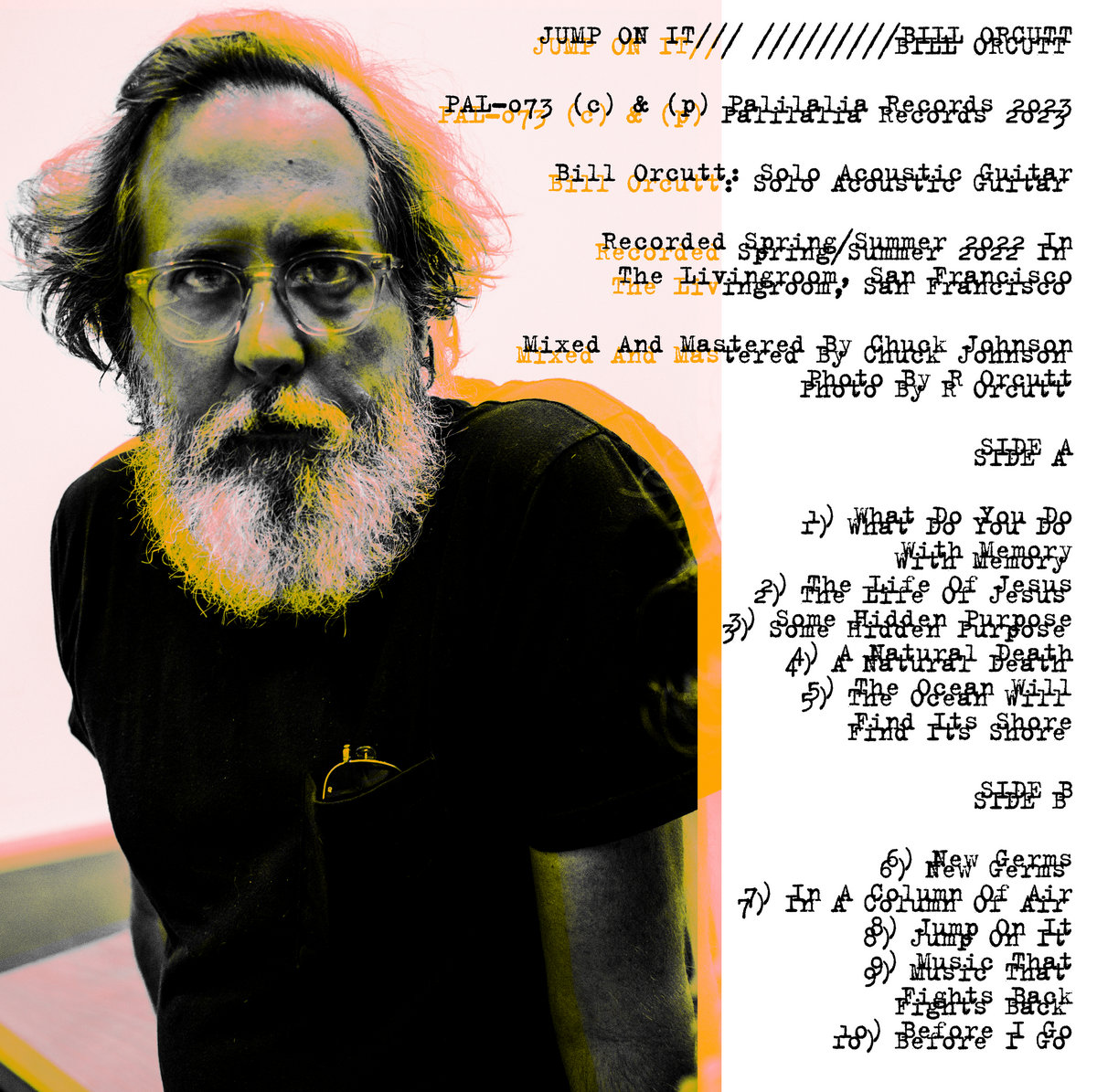 This latest LP from San Francisco-based guitar visionary Bill Orcutt is a spiritual successor of sorts to 2013's A History of Every One, as that was apparently his last solo acoustic guitar album. The resemblance between the two albums largely ends there, however, as Jump On It is as different from the deconstructed standards of History as it is from last week's Chatham-esque guitar quartet performance for NPR. While I do enjoy Orcutt's Editions Mego solo era quite a bit, there is no denying that his artistry has evolved dramatically over the last decade and his recent work definitely connects with me on a deeper level. In more concrete terms, Orcutt's work no longer resembles the choppy, convulsive, and possessed-sounding fare of History, as he has since reined in his more fiery, passionate impulses enough to leave more room for passages of tender, simple beauty. In fact, Jump On It might be the farthest that the balance has swung towards the latter, as the characteristic Orcutt violence is a rare presence in the collection of quietly lovely and spontaneous-sounding guitar miniatures.
This latest LP from San Francisco-based guitar visionary Bill Orcutt is a spiritual successor of sorts to 2013's A History of Every One, as that was apparently his last solo acoustic guitar album. The resemblance between the two albums largely ends there, however, as Jump On It is as different from the deconstructed standards of History as it is from last week's Chatham-esque guitar quartet performance for NPR. While I do enjoy Orcutt's Editions Mego solo era quite a bit, there is no denying that his artistry has evolved dramatically over the last decade and his recent work definitely connects with me on a deeper level. In more concrete terms, Orcutt's work no longer resembles the choppy, convulsive, and possessed-sounding fare of History, as he has since reined in his more fiery, passionate impulses enough to leave more room for passages of tender, simple beauty. In fact, Jump On It might be the farthest that the balance has swung towards the latter, as the characteristic Orcutt violence is a rare presence in the collection of quietly lovely and spontaneous-sounding guitar miniatures. Finally seeing the light of day after two years of production related delays, with the recordings dating back even longer than that, this collaboration between Daniel Burke (IOS) and the late Stefan Weisser (Z'EV) could almost be a time capsule, except the sound of it is entirely timeless. Recorded and mixed between 2008 and 2012, the two lengthy pieces that make up this self-titled album clearly bear the mark of both individuals, but mesh together beautifully in the very different sounding sides of the record.
Finally seeing the light of day after two years of production related delays, with the recordings dating back even longer than that, this collaboration between Daniel Burke (IOS) and the late Stefan Weisser (Z'EV) could almost be a time capsule, except the sound of it is entirely timeless. Recorded and mixed between 2008 and 2012, the two lengthy pieces that make up this self-titled album clearly bear the mark of both individuals, but mesh together beautifully in the very different sounding sides of the record. A 10" record rigidly divided into four different pieces (each mostly around four minutes in length), this new work from the enigmatic sounding, long-standing UK project is mostly centered around the same authoritarian lyrical elements, but each differs significantly in their compositional approach. A complex mix of styles define each piece, neither of which are too similar to another, but are unquestionably Contrastate, and showcases all of the unique sounds they are known for.
A 10" record rigidly divided into four different pieces (each mostly around four minutes in length), this new work from the enigmatic sounding, long-standing UK project is mostly centered around the same authoritarian lyrical elements, but each differs significantly in their compositional approach. A complex mix of styles define each piece, neither of which are too similar to another, but are unquestionably Contrastate, and showcases all of the unique sounds they are known for.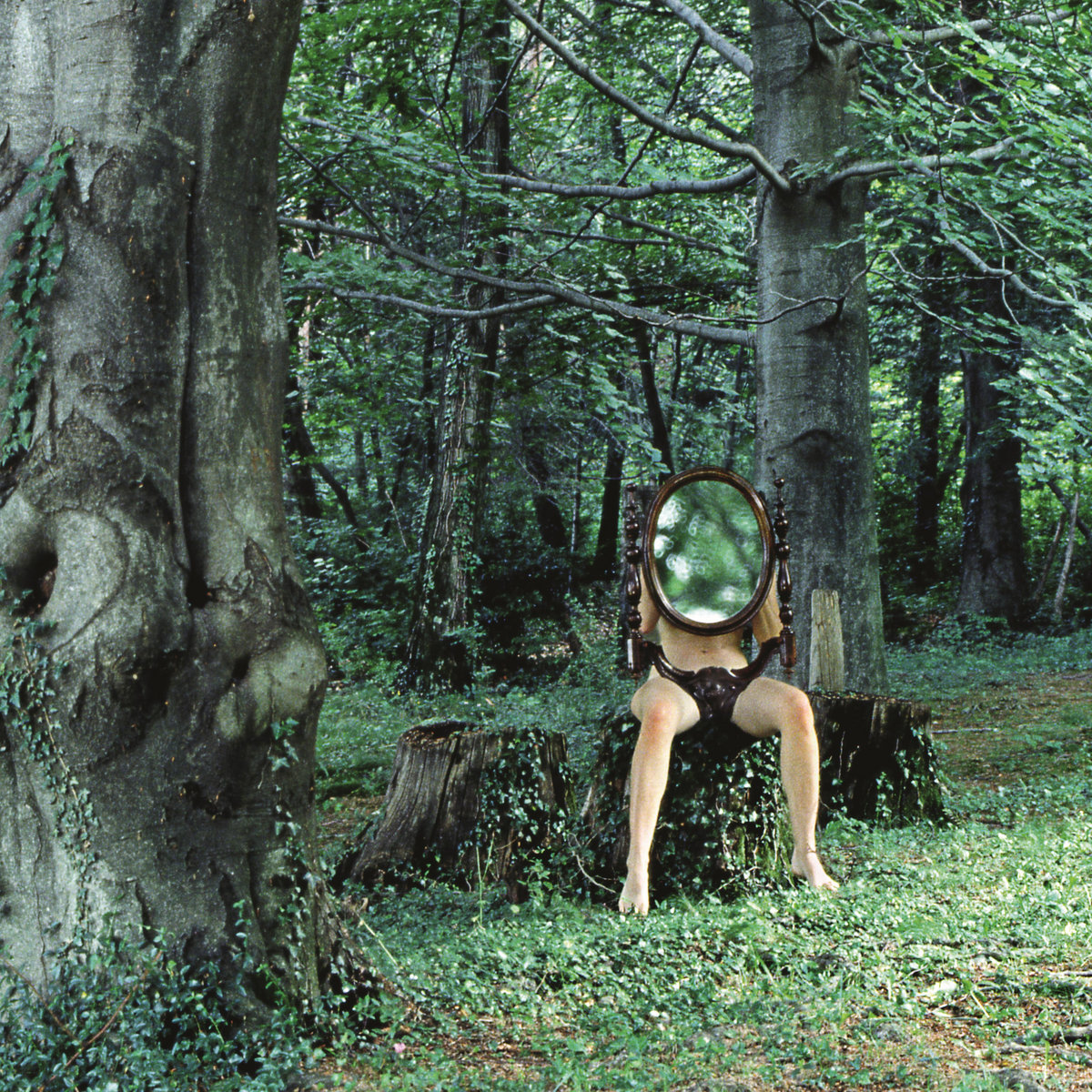 This eleventh album from Germany's Kammerflimmer Kollektief is not my first exposure to the project, but it did succeed in making me wonder why I have not been a passionate fan of their work before now. Admittedly, the idea of harmonium-driven free-form jazz/psychedelia is not quite my cup of tea on paper, which goes a long way towards explaining why I was so slow to embrace this project, yet the right execution can transform just about anything into gold and this foursome are extremely good at what they do. It also does not hurt that the Kammerflimmer gang have some intriguing and unusual inspirations, as they namecheck both Franz Mesmer and underheard German psychonauts The Cocoon in addition to the requisite nod to Can. Kammerflimmer Kollektief certainly assimilate those influences in a unique way though, as the best songs on Schemen sound like a killer post-rock/psych band blessed with an unusually great rhythm section and real talents for roiling guitar noise, simmering tension, and volcanic catharsis.
This eleventh album from Germany's Kammerflimmer Kollektief is not my first exposure to the project, but it did succeed in making me wonder why I have not been a passionate fan of their work before now. Admittedly, the idea of harmonium-driven free-form jazz/psychedelia is not quite my cup of tea on paper, which goes a long way towards explaining why I was so slow to embrace this project, yet the right execution can transform just about anything into gold and this foursome are extremely good at what they do. It also does not hurt that the Kammerflimmer gang have some intriguing and unusual inspirations, as they namecheck both Franz Mesmer and underheard German psychonauts The Cocoon in addition to the requisite nod to Can. Kammerflimmer Kollektief certainly assimilate those influences in a unique way though, as the best songs on Schemen sound like a killer post-rock/psych band blessed with an unusually great rhythm section and real talents for roiling guitar noise, simmering tension, and volcanic catharsis. In the village of Stanton Drew, and dating from around 4,500 years ago, is the third largest complex of standing stone circles in England. David Colohan visited the site one rainy morning in early 2020 and was inspired by the mix of winter sunshine and eerie ancient atmosphere to create a record of his impressions. Fair enough, since people rarely send postcards from their travels anymore. Actually, the postcard analogy only works if it allows for someone designing a postcard when they get home, since Colohan's use of field recordings is minimal and he doesn't really create music in situ. He's done this before with other locations but A Lunar Standstill is easily his most consistent recording.
In the village of Stanton Drew, and dating from around 4,500 years ago, is the third largest complex of standing stone circles in England. David Colohan visited the site one rainy morning in early 2020 and was inspired by the mix of winter sunshine and eerie ancient atmosphere to create a record of his impressions. Fair enough, since people rarely send postcards from their travels anymore. Actually, the postcard analogy only works if it allows for someone designing a postcard when they get home, since Colohan's use of field recordings is minimal and he doesn't really create music in situ. He's done this before with other locations but A Lunar Standstill is easily his most consistent recording.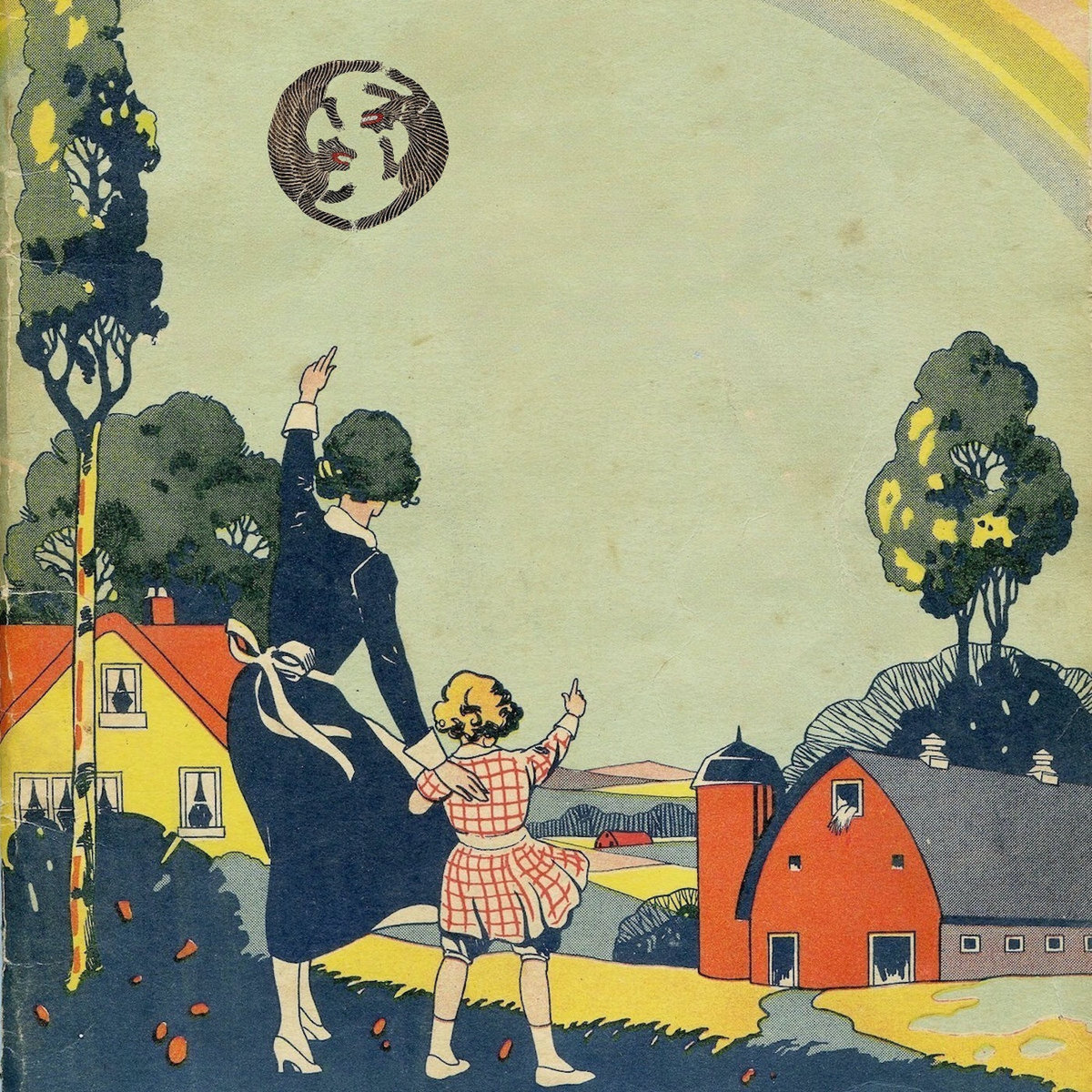 This latest release from husband and wife duo Zach & Denny Corsa appears to be their fifth full-length under the Nonconnah name (the duo were previously known as Lost Trail) and it is characteristically wonderful. As is the norm for Nonconnah, Unicorn Family was culled from several years of recordings featuring a host of eclectic collaborators (folks from Lilys, Half Japanese, Fire-Toolz, etc.) and those recordings have been expertly stitched together into beautifully layered and evocative soundscapes teeming with cool tape effects, thought-provoking samples, and killer shoegaze-inspired guitar work. In short, business as usual, but Nonconnah's business is consistently being one of the greatest drone projects on earth, so this is already a lock for one of my favorite albums of the year. Aside from the presence of a lovely lo-fi folk gem with actual singing, the only other notable departures from Nonconnah's existing run of gorgeous albums are shorter song durations than usual and the fact that the duo's samples have more of an eschatological bent. I suppose this album is an unusually focused and distilled statement as well, but that feels like a lateral move given how much I loved the sprawling immensity of Don't Go Down To Lonesome Holler.
This latest release from husband and wife duo Zach & Denny Corsa appears to be their fifth full-length under the Nonconnah name (the duo were previously known as Lost Trail) and it is characteristically wonderful. As is the norm for Nonconnah, Unicorn Family was culled from several years of recordings featuring a host of eclectic collaborators (folks from Lilys, Half Japanese, Fire-Toolz, etc.) and those recordings have been expertly stitched together into beautifully layered and evocative soundscapes teeming with cool tape effects, thought-provoking samples, and killer shoegaze-inspired guitar work. In short, business as usual, but Nonconnah's business is consistently being one of the greatest drone projects on earth, so this is already a lock for one of my favorite albums of the year. Aside from the presence of a lovely lo-fi folk gem with actual singing, the only other notable departures from Nonconnah's existing run of gorgeous albums are shorter song durations than usual and the fact that the duo's samples have more of an eschatological bent. I suppose this album is an unusually focused and distilled statement as well, but that feels like a lateral move given how much I loved the sprawling immensity of Don't Go Down To Lonesome Holler.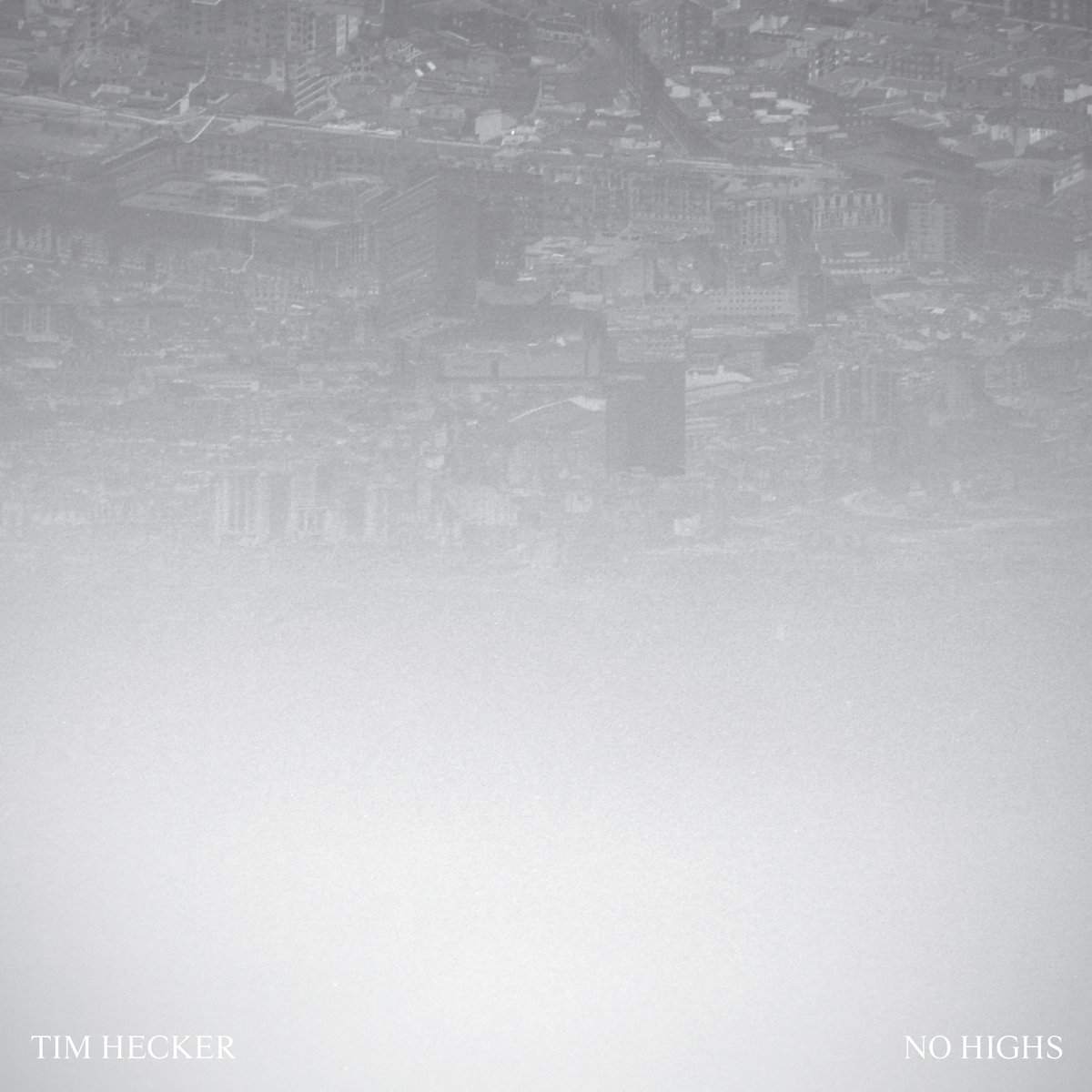 This latest opus from Tim Hecker is amusingly billed as "a beacon of unease against the deluge of false positive corporate ambient." Given the weighty themes of his previous albums, Hecker's actual inspiration presumably runs much deeper than that, yet the "beacon of unease" part of that claim may be more literal than it sounds, as one of the album's central features is described as "Morse code pulse programming." While I am not well-versed enough in Morse code to determine if Hecker's oddly timed rhythms are covertly incorporating text or a narrative into these warped and nightmarish soundscapes, the gnarled and harrowing melodies that accompany those erratic pulses are more than enough to make the album thoroughly compelling listening regardless. Aside from that, No Highs marks yet another significant creative breakthrough for a formidable artist hellbent on continual reinvention and bold evolution. While it is hard to predict whether or not No Highs will someday be considered one of Hecker's defining masterpieces or merely an admirable and unique detour, its handful of set pieces feel quite brilliant to me and I do not expect my feelings to change on that point..
This latest opus from Tim Hecker is amusingly billed as "a beacon of unease against the deluge of false positive corporate ambient." Given the weighty themes of his previous albums, Hecker's actual inspiration presumably runs much deeper than that, yet the "beacon of unease" part of that claim may be more literal than it sounds, as one of the album's central features is described as "Morse code pulse programming." While I am not well-versed enough in Morse code to determine if Hecker's oddly timed rhythms are covertly incorporating text or a narrative into these warped and nightmarish soundscapes, the gnarled and harrowing melodies that accompany those erratic pulses are more than enough to make the album thoroughly compelling listening regardless. Aside from that, No Highs marks yet another significant creative breakthrough for a formidable artist hellbent on continual reinvention and bold evolution. While it is hard to predict whether or not No Highs will someday be considered one of Hecker's defining masterpieces or merely an admirable and unique detour, its handful of set pieces feel quite brilliant to me and I do not expect my feelings to change on that point.. This is the debut collaboration between two Berlin-based Peruvian musicians and also marks my first exposure to percussionist Laura Robles. I am, however, reasonably familiar with the alien soundscapes of Ale Hop (Alejandra Cárdenas) and this union seems to have inspired some of her finest work to date. Notably, Robles is "reputed to be one of the best cajón players in Peru," which is useful context given how radically (yet lovingly) the pair deconstruct and reinvigorate the instrument ("a symbol of resistance, experimentation and transformation" in Peru). In more practical terms, that means that Cárdenas and Robles dramatically disrupt, distort, and repurpose traditional dance rhythms into a wild psychotropic mindfuck. In fact, it sometimes sounds like Robles recorded her parts alone as a freeform performance at an Ayahuasca ceremony or something, but the seemingly roving and divergent threads always come together in impressive fashion in the end. Amusingly, I would have thought that the enigmatically and erratically shifting rhythms of Agua dolce would be damn near impossible to dance to, yet these pieces apparently made quite a splash when the duo coupled with dancer/choreographer Liza Alpiźar Aguilar for the Heroines Of Sound festival. Whether or not that means that I would be a terrible choreographer is hard to say, however, as the finished album may have ultimately landed in far more lysergic territory due to Cárdenas' additional edits and production wizardry.
This is the debut collaboration between two Berlin-based Peruvian musicians and also marks my first exposure to percussionist Laura Robles. I am, however, reasonably familiar with the alien soundscapes of Ale Hop (Alejandra Cárdenas) and this union seems to have inspired some of her finest work to date. Notably, Robles is "reputed to be one of the best cajón players in Peru," which is useful context given how radically (yet lovingly) the pair deconstruct and reinvigorate the instrument ("a symbol of resistance, experimentation and transformation" in Peru). In more practical terms, that means that Cárdenas and Robles dramatically disrupt, distort, and repurpose traditional dance rhythms into a wild psychotropic mindfuck. In fact, it sometimes sounds like Robles recorded her parts alone as a freeform performance at an Ayahuasca ceremony or something, but the seemingly roving and divergent threads always come together in impressive fashion in the end. Amusingly, I would have thought that the enigmatically and erratically shifting rhythms of Agua dolce would be damn near impossible to dance to, yet these pieces apparently made quite a splash when the duo coupled with dancer/choreographer Liza Alpiźar Aguilar for the Heroines Of Sound festival. Whether or not that means that I would be a terrible choreographer is hard to say, however, as the finished album may have ultimately landed in far more lysergic territory due to Cárdenas' additional edits and production wizardry.
